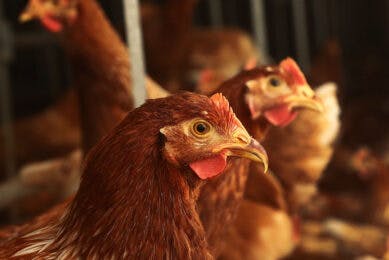
Campylobacteriosis in Birds
Etiology
Infection of the intestinal tract with Campylobacter jejuni and other Campylobacter spp is common in poultry and waterfowl but is not typically associated with clinical signs of disease. Exceptions are C hepaticus and C bilis, which have been reported to cause spotty liver disease in layer chickens and decrease egg production. Bacterial isolation remains the standard method for detection, but PCR assay is increasingly used for diagnosis. No treatment is needed for most avian Campylobacter infections, but C hepaticus outbreaks may be treated by antimicrobials. Some poultry Campylobacter species, particularly C jejuni, are a common source of infections in humans.
Epidemiology
Columbiformes and domestic and free-living Galliformes and Anseriformes birds are natural reservoirs of human pathogenic Campylobacter spp (C jejuni, C coli, and C lari) and other poorly defined Campylobacter spp. Many commercial broiler and turkey flocks harbor C jejuni, although the prevalence can vary depending on season and age of the birds. Environmental contamination with bird feces is a common source of infection, along with insects, fomites, and contaminated water and feed. Transmission can occur vertically, and rapid transmission within flocks is common once the organism is introduced into the environment.
Clinical Findings
Campylobacteriosis does not commonly cause clinical signs in poultry and other birds. However, Campylobacter hepaticus and C bilis cause spotty liver disease in layer chickens and are associated with decreased egg production. Clinical signs may include multifocal necrotic hepatitis, egg production losses, and increased flock mortality rate.
Diagnosis
Diagnosis of campylobacteriosis in birds is based on clinical signs and detection of the pathogen. Bacteriologic culture or PCR assay can be used for diagnosis, with clinical signs being particularly important for C hepaticus. There are no reliable serologic tests for Campylobacter in avian species.
Control and Prevention
Improved biosecurity, hygiene practices, and antimicrobial treatment for C hepaticus outbreaks are key components of control and prevention measures. No effective vaccine is available for Campylobacteriosis in birds.
Zoonotic Risk
Campylobacter jejuni is a major source of foodborne enteritis in humans, often acquired through consumption of undercooked poultry meat contaminated with the bacteria. Other sources of infection include nonchlorinated ground water, unpasteurized milk, diarrheic pets, and contaminated beef and pork products. Proper cooking and hygiene practices are essential to reduce the risk of foodborne infection.
Key Points
- Campylobacteriosis is common in poultry and waterfowl but is usually asymptomatic.
- C hepaticus and C bilis can cause spotty liver disease and decreased egg production in layer chickens.
- Improved biosecurity, hygiene, and antimicrobial treatment are important for control and prevention.
- Campylobacter jejuni is a major cause of foodborne enteritis in humans, highlighting the zoonotic risk associated with avian Campylobacter infections.
